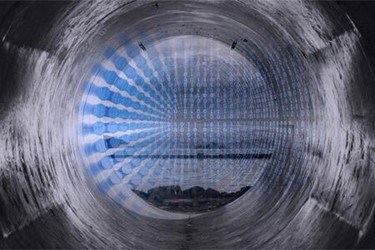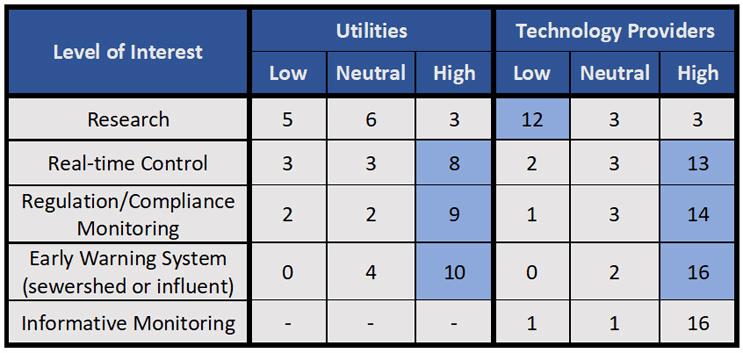2018 — The Year Of Smart Wastewater
By Sam Konstantinov, Research Analyst, SWAN Forum

2017 was a transformative year for the smart wastewater sector with major industry advancements such as new ways to detect and prevent combined sewer overflows (CSOs), the advent of a smart wastewater pumping system, and the emergence of innovative business models such as data-as-a-service — all bound to gain more traction in 2018.
In 2017, SWAN conducted an Urban Sewershed Monitoring Survey on behalf CH2M and WE&RF to analyse the existing challenges, capabilities, and state of implementing sensor networks in urban sewersheds (sewer collection systems). The groundbreaking study was completed by 20 utilities and 20 technology providers, with the below chart illustrating how each group ranked the most important uses for sensor technology in wastewater networks.

Source: SWAN, CH2M and WE&RF Sewershed Monitoring Survey, 2017
These results demonstrate a growing interest in advanced sensor applications in wastewater solutions. Both utilities and technology providers indicated the most important uses for sensors were for an early warning system, followed by compliance monitoring, and real-time control.
Fueled by this increased interest, SWAN and industry leaders have identified the following smart wastewater trends likely to be at the forefront of 2018 discussions:
Detecting and Preventing CSOs
Wastewater utilities are increasingly implementing technologies to ensure compliance and addressing such challenges as inflow and infiltration (I&I) and combined sewage overflows (CSOs). During rain events, stormwater overwhelms the capacity of a combined sewer systems resulting in harmful overflow events. Companies such as SmartCover Systems and ADS provide solutions to detect and reduce overflows by utilising real-time flow and weather data, and similarly Eastech uses sensors for micro I&I detection. Data-driven solutions to address CSOs will remain a priority for utilities in 2018, as these approaches are proven to be more effective and efficient.
Real-Time Network Control
Employing EmNet’s real-time control solution, the City of South Bend, IN, was able to effectively leverage data analytics to automatically control valves and optimise their wastewater system. EmNet’s system intelligently and dynamically adapts to changing storm conditions to maximise storage and conveyance. This enabled South Bend to reduce overflow events from a yearly average of 27 to only 1. Digital solutions can also be used to evaluate and finance infrastructure initiatives to reduce CSOs.
Funding Green Infrastructure
Inadequate stormwater management practices have directly contributed to higher CSO volumes. Since most infrastructure is not permeable, stormwater is often funneled through large areas into centralised locations, which then deliver large runoff volumes into combined sewer systems. In a progressive move, DC Water was able to finance its permeable surface infrastructure initiative through an Environmental Impact Bond and use data-driven flow models to evaluate the impact of permeable surface infrastructure. This allowed DC Water to avoid a $3.3 million contingent payment. In addition to reducing CSO volumes, data oriented management practices can increase energy efficiency within wastewater networks.
Maximizing Pump Efficiency
In 2017, DC Water introduced Xylem’s smart wastewater pump system. This interconnected system is expected to produce energy savings of up to 70 percent compared to a conventional pumping system and reduce inventory by up to 80% due to flexible performance. Emerging business models in the smart wastewater market also promise to create new partnerships and initiatives between technology providers and utilities.
Implementing the DaaS Business Model
One of the greatest challenges in integrating new digital wastewater technologies is convincing utilities to take on the risks of emerging technology solutions. The data-as-a-service (DaaS) business model addresses this challenge by shifting project risks onto technology providers. In this scenario, utilities only pay for the final data they receive and do not incur any technology related costs. This model is already proving successful in India through s::can’s Ganges River project. Using water quality monitoring stations measuring 17 different parameters, s::can is able to register live spikes in hazardous chemicals.
Looking Towards 2018
Trend-setting, progressive utilities like the City of South Bend and DC Water are laying down the groundwork for continued integration of smart wastewater solutions in 2018. Challenges in controlling CSO events, increasing energy efficiency, and ensuring effective implementation will need to be met with new digital solutions and innovative business models.
To learn more about the latest smart water and wastewater trends, challenges, and solutions, SWAN invites everyone to the 2018 SWAN Annual Conference in Barcelona. Join us May 21-22 to learn about how smart water can meet tomorrow’s challenges today.
